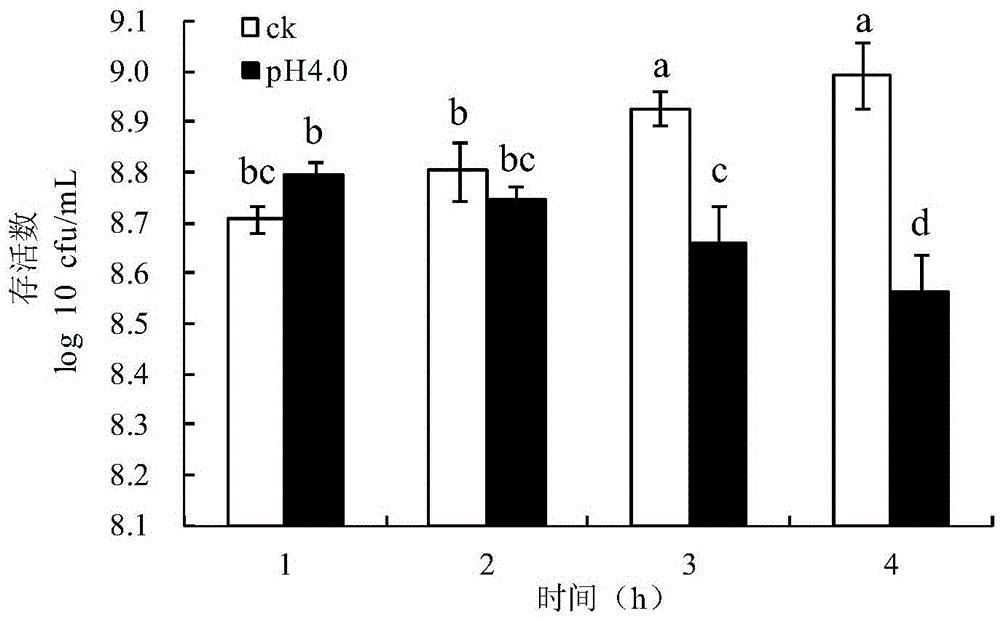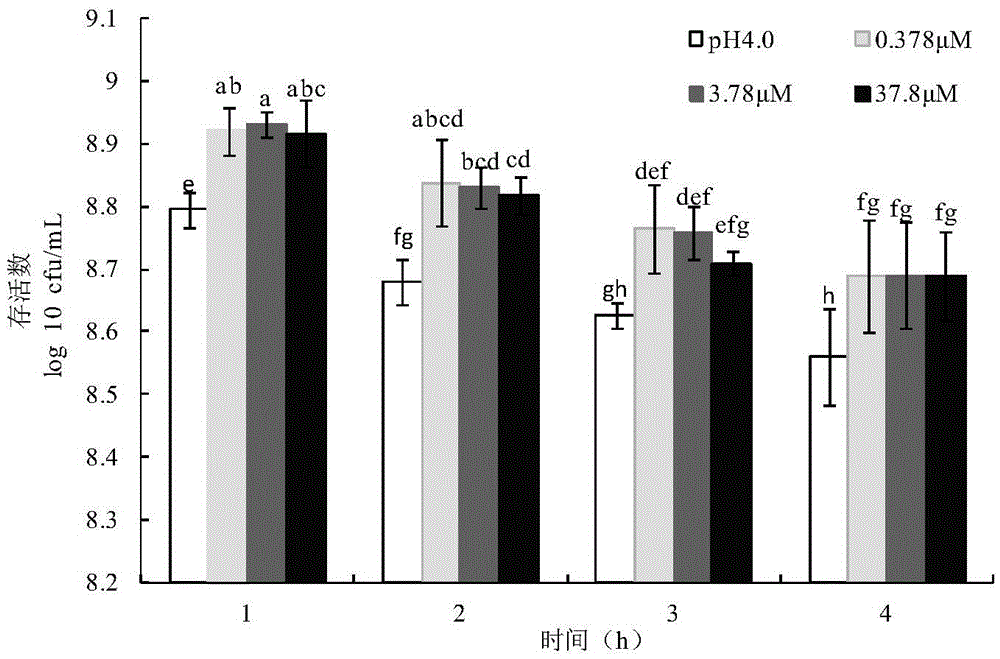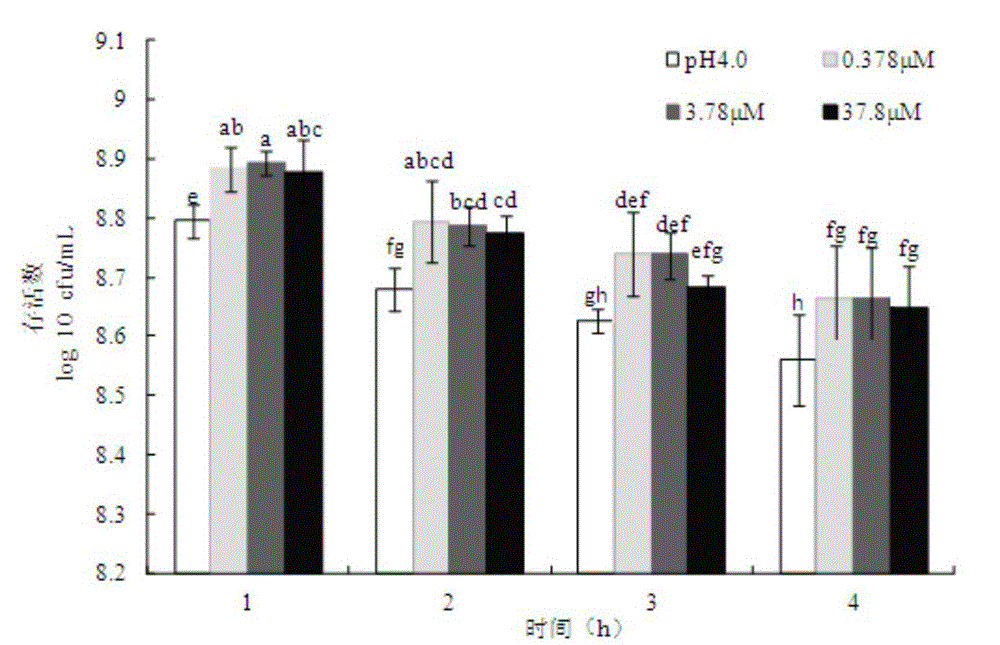Application of AI-2 in improving bacteria acid resistance and/or oxygen resistance and method for improving bacteria acid resistance and/or oxygen resistance
An AI-2, acid-resistant technology, applied in the field of microorganisms, can solve the problems of poor taste, unstable genetic characteristics of bifidobacteria, and complicated operation.
- Summary
- Abstract
- Description
- Claims
- Application Information
AI Technical Summary
Problems solved by technology
Method used
Image
Examples
Embodiment 1
[0045] The effect of formula (1) compound on the acid resistance of bifidobacteria during acid stress
[0046] (1) Verification of acid stress
[0047] Inoculate 1% in the MRS liquid culture medium from CGMCCNo.2265 (BBMN68) seed culture liquid, 37 ℃ of anaerobic cultures, reach mid-logarithmic phase (about 6h) and get bacterial liquid sample, measure OD600 (reached) with ultraviolet-visible spectrophotometer 0.6 or more), divide the bacterial liquid into two parts A, B, C and D, and centrifuge at 8000rpm for 5min; discard the supernatant, and use MRS with pH6.5, pH4.0, pH2.5 and pH1 respectively Wash bacterial cells A, B, C, and D with liquid medium, centrifuge again: 8000rpm, 5min; discard the supernatant, and resuspend the precipitates A, B, C, and D in equal volumes of pH 6.5 and pH 4.0 respectively. , MRS liquid medium of pH 2.5 and pH 1, anaerobic culture at 37°C, take A, B, C, and D bacteria liquids at 1h, 2h, 3h, and 4h respectively, dilute 10 times with the diluent, ...
Embodiment 2
[0056] When being used for illustrating acid stress, the compound shown in formula (1) is to the impact of bifidobacterium acid resistance
[0057] The acid stress experiment of the pH4 group was carried out according to the method of Example 1, except that the bifidobacterium used was Bifidobacterium juvenile CGMCC No.6270.
[0058] The results showed that with the prolongation of the culture time, the number of survivors in the pH4.0 control group and the groups added with different concentrations of the compound of formula (1) decreased gradually. At each time point, the number of survivors who added different concentrations of the formula (1) compound group was significantly higher than that of the pH4.0 control group (such as image 3 Shown), but the degree of improvement is significantly lower than in Example 1. However, there was no significant difference in the number of survivors among groups of compounds of the same different concentrations of formula (1).
[0059]...
Embodiment 3
[0066] Effect of compounds shown in formula (1) on oxygen tolerance of bifidobacteria during oxygen stress
[0067] (1) Verification of oxygen stress
[0068] Inoculate 1% of the BBMN68 seed culture solution into the MRS liquid medium, culture anaerobically at 37°C, and inoculate the bacterial solution into the MRS medium with different concentrations of oxygen according to the inoculation amount of 1% after activation for one generation, respectively B: Filled with N2, does not contain CYS (dissolved oxygen is about 0.4mg / L), C: contains 0.05% by weight of CYS, does not fill with N2 (corresponding oxygen concentration is 0.5mg / L) and D: does not fill with N2 , also does not contain CYS (the corresponding oxygen concentration is 2mg / L), strictly anaerobic (A: containing the concentration of 0.05% by weight of CYS and containing the concentration of 99% by volume of N 2 ). Cultivate at 37°C, measure OD600 with a UV-visible spectrophotometer every 2 hours until 12 hours, the r...
PUM
 Login to View More
Login to View More Abstract
Description
Claims
Application Information
 Login to View More
Login to View More - R&D Engineer
- R&D Manager
- IP Professional
- Industry Leading Data Capabilities
- Powerful AI technology
- Patent DNA Extraction
Browse by: Latest US Patents, China's latest patents, Technical Efficacy Thesaurus, Application Domain, Technology Topic, Popular Technical Reports.
© 2024 PatSnap. All rights reserved.Legal|Privacy policy|Modern Slavery Act Transparency Statement|Sitemap|About US| Contact US: help@patsnap.com










